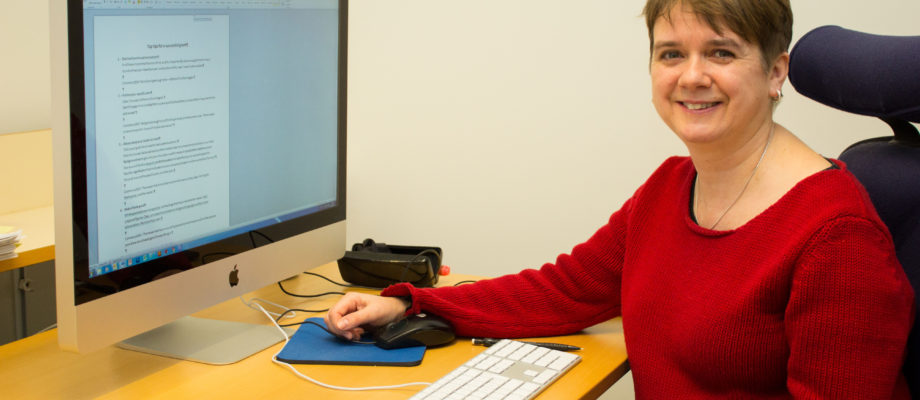WRITING SUPPORT. For ten years, the Wallenberg Laboratory has had its own scientific editor, who scrutinizes both grant proposals and manuscripts before they are submitted. Rosie Perkins shares with us some of her best advice on how to significantly improve your grants and manuscripts.
Rosie Perkins is rarely short of work at the Wallenberg Laboratory. She divides her time between refining papers for journals and grant applications to various funding agencies.
“The best thing about my job is helping researchers develop their writing so that their submitted text is well structured with a clear message,” says Rosie Perkins, who herself holds a PhD in pharmacology from Imperial College, London.
She began working as an editor for the scientific publisher Elsevier in the UK after completing her PhD. She moved to Gothenburg 13 years ago when her husband had the opportunity of a one-year international assignment at AstraZeneca. They liked it here and have stayed ever since.
Unusual expertise
People who both hold a PhD and have experience of editing are hard to find, and Jan Borén is very pleased that the Wallenberg Laboratory was able to hire Rosie Perkins:

“I have reviewed thousands of grants for different funding agencies and I am amazed how many researchers do not spend enough time on their proposals. It is critical that you clearly describe what you intend to do, how you will do it, and why it is worthwhile. It is not easy to write a grant and a lot of training is required to achieve success. Grants are often reviewed by researchers who do not have detailed knowledge of your particular area of research and therefore it is crucial that the grant is well structured and easy to read,” says Jan Borén.
“Rosie makes an important contribution to the scientific community at the Wallenberg Laboratory. I am convinced that other departments at the Sahlgrenska Academy would benefit from employing scientific editors, but it is not easy to find them because they should have a solid scientific background together with excellent language skills.”
Sharpening the message
Contrary to popular belief, scientific editors do a lot more than just correcting spelling and grammar errors. Rosie Perkins stresses that a large part of her job is to work out the main message and then decide how to get it across in the clearest way possible. She ensures that the writing is well structured and that there are no logical gaps in the text that can confuse the reader.
“The most common mistake I see is that researchers lack focus in their writing. It’s much easier to write clearly when you have a single message and remember what the message is throughout the process,” says Rosie Perkins.
For anyone who wants to improve their chances of being awarded a grant, her advice is to allow plenty of time and start by reading the instructions carefully. She believes that the most successful grant proposals are started several months before the deadline.
“If you’re well prepared when a call for proposals opens, you have time to ask for feedback and to rewrite the parts of the application that need improving.” says Rosie Perkins.
 TOP FIVE TIPS FOR A SUCCESSFUL GRANT
TOP FIVE TIPS FOR A SUCCESSFUL GRANT
Akademiliv asked Rosie Perkins to compile her best advice for a really good application:
- Start early and read the instructions
“It will take more time than you think and it’s important that you allow enough time for several rounds of revision. If this year’s instructions haven’t been published yet, read last year’s instructions.”
- Perfect your specific aims
“The aims should be clear, focused and worthwhile. Identify important knowledge gaps in your scientific field that only you are qualified to fill. Think about how the proposed research will push the field forward.”
- Always keep your reader in mind
“Write your application so that it appeals to a broad but educated audience. Optimize the structure and use clear, concise and consistent language so that it is easily read and understood by someone who is not a specialist in your field. Avoid using jargon and abbreviations. And balance the sections. The background should help the reader understand why this research is needed. The project description should explain how you will conduct the research. Include preliminary data to show that the research you’re proposing is feasible. In the significance section, emphasize how your proposed research will move the field forward. Focus everything around your specific aims, and join the dots. Don’t forget you are writing for the reviewers and not for yourself.”
- Make it look good
“It is all too common that the first draft of a grant I receive is a dense, poorly structured wall of text. In this case, I have to take a deep breath before I start to read it and I’m immediately put off. I’m sure it’s similar for the reviewers, so allow some time to make it look good. Shorten the text, and ensure there is white space between your paragraphs. Use subheadings that help orientate the reader. Include some well-prepared figures.”
- Ask for feedback and be prepared to act on it
“Allow enough time to ask two or three other researchers to read your application, and be prepared to act on their comments. Ask for feedback on your specific aims at an early stage and then later on a more final draft. Don’t get too attached to your writing – be prepared to re-write if necessary. You can’t expect to get useful feedback if you ask others to read your application just a few days before the deadline.”











